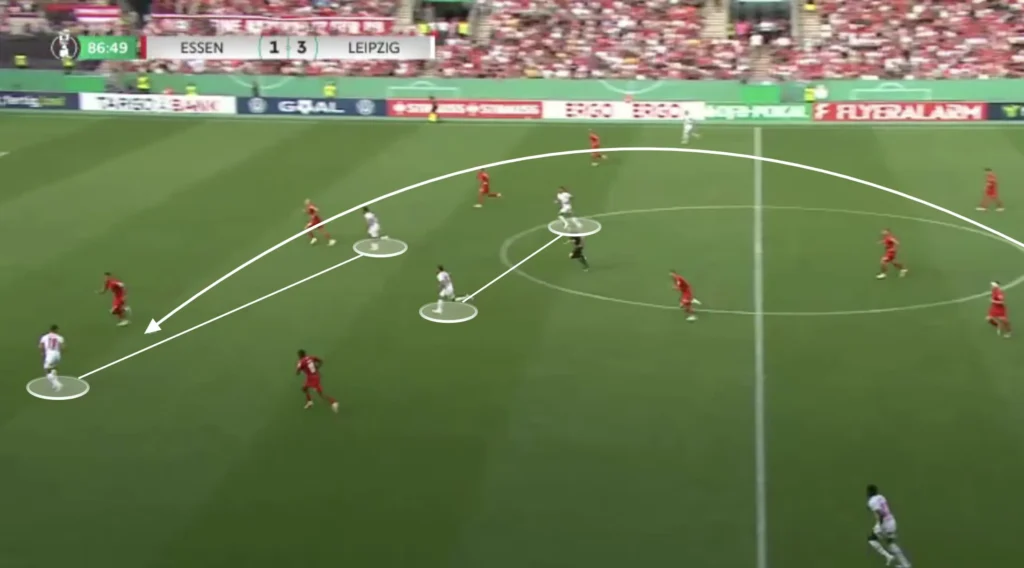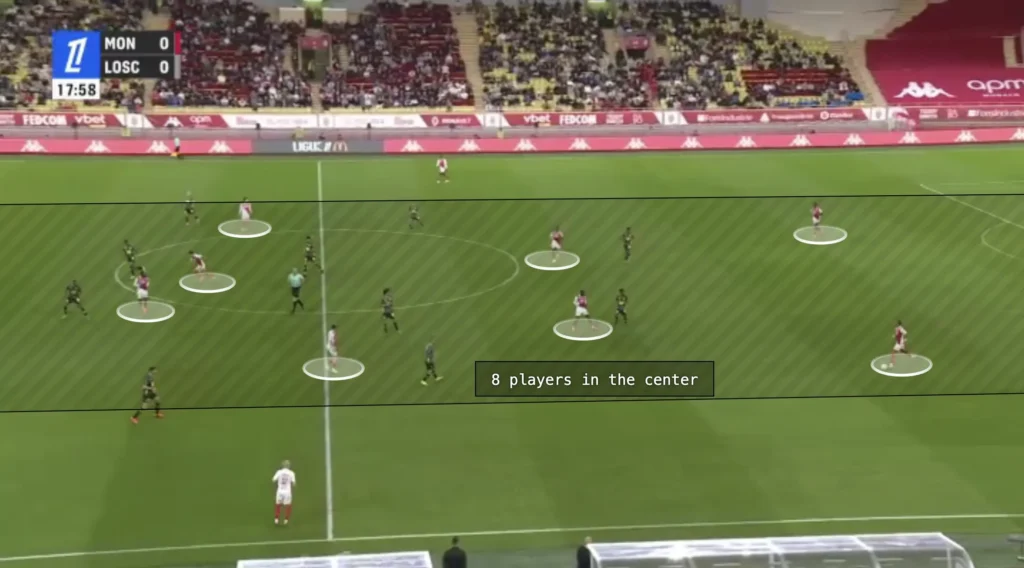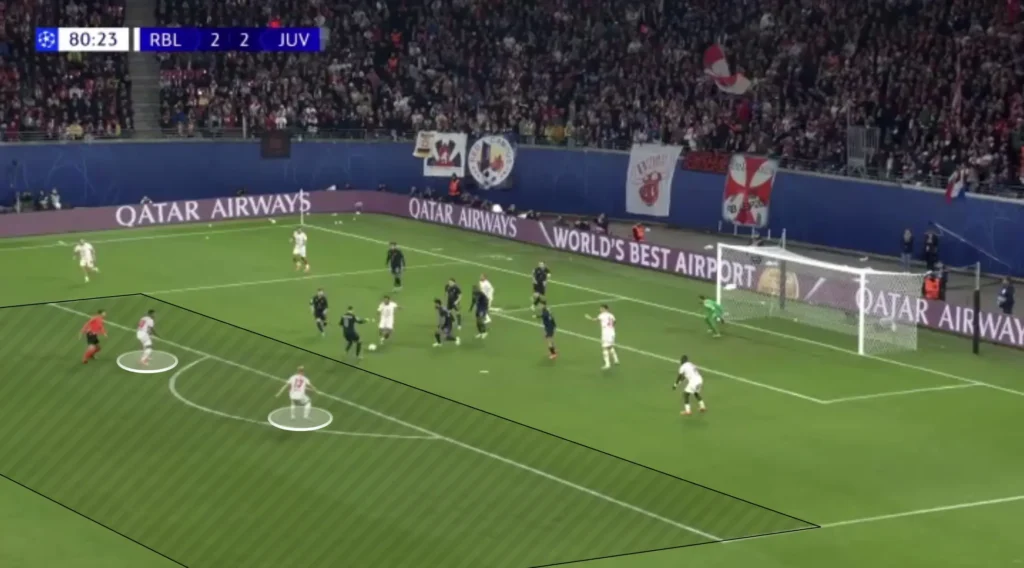The 1-4-2-2-2 formation is a fascinating and versatile setup in football, combining defensive flexibility with attacking creativity. Known for its balance between structure and fluidity, this formation has gained popularity among modern coaches looking to dominate both ends of the pitch. In this article, we’ll break down the key principles of the 1-4-2-2-2, explore its strengths and weaknesses, and show how teams utilize it to control the game. Whether you’re a player, coach, or football enthusiast, this tactical breakdown will help you understand why the 1-4-2-2-2 continues to be a go-to strategy for many teams worldwide.
Build-up
Building up in the 1-4-2-2-2 formation requires precision and coordination to maximize its unique structure. The double pivot in midfield provides stability and options for the center-backs during the initial build-up phase, allowing for smoother ball progression. The two advanced midfielders, positioned narrowly, create central overloads, offering passing lanes and opportunities for quick combination play. Fullbacks play a crucial role in providing width, as the narrow positioning of the attacking midfielders often draws defenders inside. Strikers in this formation are key to stretching the opposition backline, making runs to open space or dropping slightly to link up with the midfield.

This setup encourages vertical progression, quick transitions, and fluid interplay, making it effective against compact defensive setups.
Low Build-up
In the low build-up, the 1-4-2-2-2 formation creates numerical advantages by utilizing the two deep-lying midfielders and the goalkeeper to build out from the back. The center-backs split wide to provide passing lanes, while the fullbacks push slightly higher to offer width. The two central midfielders drop deep to act as outlets, ensuring short passing options and aiding in bypassing the opponent’s press. The two attacking midfielders operate in the half-spaces, positioning themselves between the lines to receive passes and link play. Meanwhile, the two strikers stay higher up the pitch, stretching the opposition’s defense and creating vertical passing options.
Low build-up vs Back Four
In the 1-4-2-2-2, building from the back against a team pressing with a back four creates a natural 9v6 numerical advantage in the build-up phase. The two strikers occupy the attention of the opposition’s back four, reducing their ability to press higher up the pitch. This setup gives the goalkeeper, defenders, and midfielders more time and space to progress the ball.

Low build-up vs Back Three
When facing a team pressing with a back three, the 1-4-2-2-2 formation still creates a 9v7 numerical advantage in the build-up phase. The two strikers occupy the attention of the three center-backs, leaving the rest of the team with extra space and options to progress the ball.

Progressing the Ball
In the 1-4-2-2-2 formation, teams can effectively progress the ball in the low build-up by utilizing the attacking midfielders as key connectors. The attacking midfielders position themselves between the lines, offering passing options from the backline.
The build-up often starts with the center-backs or fullbacks playing a pass into one of the attacking midfielders. These players can quickly relay the ball to a holding midfielder, who then has the field in front of them to make the next move.

From there, the holding midfielder can choose to:
- Play forward to an attacker: This is especially effective if the striker drops deep to receive or runs into space behind the opposition’s defense.
- Play to an overlapping fullback: If the fullbacks have pushed high and wide, this creates width and stretches the opposition, opening up space to progress further.


Low build-up vs man-to-man system
When facing a team that presses man-to-man, the opposition defenders are forced into a 2v2 situation against the two strikers. With the opposition marking tightly, the goalkeeper or center-backs can bypass the press by playing accurate long passes toward the strikers. The strikers, positioned high and ready to challenge, can use their physicality or movement to win the ball or create second-ball opportunities. This strategy is especially effective if the strikers are strong in aerial duels or quick to exploit gaps left by pressing defenders.

When a long ball is played, the attacking midfielders can support the strikers by positioning themselves to collect knockdowns or loose balls. This approach not only bypasses the press but also creates quick attacks, catching the opposition off-guard and creating high-quality chances.

1-4-2-2-2 with Wingers
In recent years, a variation of the 1-4-2-2-2 formation has gained popularity, particularly under coaches like Roberto De Zerbi. This setup replaces the traditional two-striker system with two wingers, adding width and unpredictability to the build-up phase.
By using two wingers instead of strikers, the attacking players start from wider positions, pulling opposition defenders out of their compact shape. This creates more space centrally for the midfielders to operate. During the build-up, the wingers stay high and wide, pinning the opposition fullbacks and stretching the field horizontally.
The main benefit of this system is that it questions the opposition center-backs, forcing them to make difficult decisions. If they push up on the attacking midfielders, the space behind them opens up, giving the wingers a 1v1 against their fullback in a massive space.

However, if they do not push up, a numerical superiority is created in the midfield, allowing the attacking team to find the attacking midfielders and play through the press.

Here, De Zerbi’s Brighton exploits the space in behind by playing a through-ball from the goalkeeper to the winger into the space that Brentford’s pushing center-backs have opened.

High Build-up
The 1-4-2-2-2 formation offers much flexibility in the high build-up.
The attacking midfielders can come wide to stretch the opposition’s backline or come inside to create overloads in the middle. A holding midfielder can drop into the backline, allowing the fullbacks to either push up or come into the midfield. The strikers could also make runs in behind or drop into the midfield to create overloads.
Numerical Advantage in the Midfield
The 1-4-2-2-2 formation naturally creates numerical superiority in central areas during the build-up phase. With two defensive midfielders, two attacking midfielders, and two strikers, there will be one player out wide on each side to pull the opposition apart while the rest create numerical advantages in the midfield areas.

This shape often makes it easier for the team in possession to progress the ball through the middle. Short, quick passing combinations exploit these overloads, while the strikers drop deeper if needed, adding more support and further overwhelming the opponent’s midfield structure. This numerical edge ensures control and dominance through the center of the pitch.
At the same time, having many players centrally builds good conditions in defensive transitions since it allows more players to counterpress when they lose the ball.

Another purpose for keeping many players in the middle is to shorten the distance between them. This shortens the length of the passes, which naturally shortens the time between passes. This means the opposition players will have less time to push up and press, giving the team more time and control with the ball.
Fullbacks Pushing Up
In the 1-4-2-2-2 formation, the fullbacks play a vital role in providing width when attacking. With the attacking midfielders operating narrowly, fullbacks push high up the pitch to stretch the opposition and create crossing opportunities. Their overlapping runs allow them to combine with the attackers, deliver crosses into the box, or draw defenders out of position. It also forces the opposing wide players to track back, relieving pressure on the holding midfielders and allowing the team to maintain possession in advanced areas.

The fullbacks can often be found in the spaces outside the opposition defense with through-balls from the midfield or backline. From this position, they will have enough time and space to take the ball forward and cross it into the attackers in the box.

Striker Partnership
The 1-4-2-2-2 formation thrives on a dynamic striker partnership. One striker may drop deep to link play, while the other makes runs in behind, creating space and stretching defenses.

Their movement often forces the opposition center-backs out of position, opening gaps for midfielders to exploit. This duo also works closely with the attacking midfielders, combining quick passes and clever positioning to maintain pressure in the final third. Together, they ensure a constant attacking threat and fluidity in the team’s play.
Finding the Pockets
In the 1-4-2-2-2 formation, the players should always try to find the attacking midfielders in the pockets. These “pockets” refer to the spaces between the opposition’s defensive and midfield lines, where the attacking midfielders can receive the ball in more advanced positions.

By positioning themselves intelligently in these pockets, the attacking midfielders can turn quickly and face the opposition’s goal, creating opportunities for through balls, driving runs, or direct shots. This positioning forces the opposition to make difficult decisions. If an opposition defender steps up and closes down the attacking midfielder, he potentially leaves space behind. If he stays back, he allows the midfielder time on the ball. The defenders and holding midfielders should look for straight or diagonal passes from the back, breaking the opposition lines and finding the attacking midfielders who can turn and drive at the defense.
The strikers in the 1-4-2-2-2 formation can further enhance the space available for the attacking midfielders by making runs in behind the opposition’s defensive line. These runs force the opposition defenders to drop deeper in order to cover the space behind them, thus creating more room in the pockets for the attacking midfielders to operate.

Teams could also use third-man combinations involving the strikers to find players in these spaces. A defender or holding midfielder can play a straight pass to a striker, who can find an attacking midfielder in the pocket with a simple one-touch pass.

Finding these pockets is crucial for maintaining fluidity in attack and ensuring that the team can progress the ball effectively through the middle of the pitch.
Creating Chances
Once the attacking midfielders receive the ball in the pockets, the team should shift gears to attack with high tempo. The strikers should rotate out of the central areas, creating even more space for themselves and the attacking midfielders. This rotation allows the strikers to exploit the space in wide areas or between the lines, giving them options to either run at goal or receive passes outside the opposition.

With the four attackers (two strikers and two attacking midfielders) now positioned in advanced areas, they can work together to attack the goal directly, using quick, direct passes and making dynamic off-the-ball runs. The tempo should remain high to catch the opposition off-guard and create fast, unpredictable attacks.

Many Players High Up the Pitch
In the 1-4-2-2-2 formation, many players will naturally be high up the pitch in attack. At least six players will be very high and can, for example, overload the box in crossing situations. The overloads in the box increase the chances of connecting with the cross, as more players present multiple targets for the crosser, making it harder for defenders to mark everyone effectively. Additionally, having multiple players in the box provides options for different types of finishes, whether it’s a header, volley, or a quick tap-in. It also allows for better positioning to react to second balls or rebounds, increasing the likelihood of capitalizing on any defensive errors.

In the 1-4-2-2-2 formation, the attacking fullbacks can score many goals from crosses at the back post. The opposition fullback will often be preoccupied with an inverted winger, which leaves massive space at the back post for the fullback to attack. The fullback can be found directly or indirectly if no one else connects with the cross.

Additionally, the two holding midfielders will be outside the box, ready for the second balls and cut-backs. In crossing situations, the opposition’s defense usually drops down, which opens the space in front of the backline. The holding midfielders can collect any loose balls or be found directly in these spaces with cut-backs, and from there, they can shoot or combine with an attacker to create goalscoring opportunities.

Exposure to Counterattacks
A key vulnerability of the 1-4-2-2-2 formation is its exposure to counterattacks, especially in wide areas. With the fullbacks pushing high to provide width, the team can leave large spaces behind them. If the initial counterpress is unsuccessful, this becomes problematic when possession is lost, as the midfielders are positioned centrally and may struggle to cover the flanks quickly.
Opponents can exploit these spaces by launching fast counterattacks down the wings, isolating the center-backs in 1v1 situations, or creating overlaps. Without proper defensive transitions and coordination, these scenarios can lead to dangerous opportunities for the opposing team. Managing this risk requires disciplined rest-defence and midfielders dropping back swiftly to support the fullbacks.
Defending in the 1-4-2-2-2 Formation
While the 1-4-2-2-2 formation is often associated with its attacking strengths, it can also serve defensive purposes when adapted properly. Out of possession, the shape offers flexibility, shifting into structures better suited for pressing or compact defending.
1-4-4-2 Defensive Shape
To create a more stable structure, the attacking midfielders typically drop into wider positions, forming a traditional 1-4-4-2 shape. This adaptation provides greater defensive width and helps cover the flanks effectively. The two central midfielders remain compact in front of the backline, shielding the defense and intercepting passes through the middle.

This 1-4-4-2 shape is particularly effective when defending deeper in a mid- or low-block, as it allows for better horizontal coverage and limits spaces for the opposition to exploit. The wingers (former attacking midfielders) can press wide players, while the strikers stay ready to capitalize on counterattacking opportunities.
Pressing in a 1-4-2-2-2
In high-pressing situations, the 1-4-2-2-2’s compactness through the center is a key strength. The two strikers press the opposition center-backs, while the attacking midfielders push up to press the fullbacks or defensive midfielders. This creates a compact structure in the midfield, congesting central passing options and forcing opponents into riskier plays.

However, this aggressive pressing requires excellent coordination and stamina. If gaps appear between the lines, the opponent can exploit them, particularly in wide areas where the fullbacks may lack immediate cover.
Strengths of the 1-4-2-2-2 in Defense
- Central Compactness: The two holding midfielders and two attacking midfielders make it difficult for opponents to progress through the middle.
- Flexibility: The ability to shift into a 1-4-4-2 adds defensive width and stability.
- Quick Transitions: The advanced positioning of the attacking midfielders and strikers makes counterattacks seamless after winning the ball.
Challenges of the 1-4-2-2-2 in Defense
- Wide Vulnerabilities: When the attacking midfielders press centrally, the flanks can be exposed if the fullbacks don’t step out quickly.
- Energy Demands: The pressing system requires high intensity and stamina from players, particularly the attacking midfielders.
- Spacing Issues: Without proper coordination, the transition from the 1-4-2-2-2 to a 1-4-4-2 can leave gaps in the defensive shape.
Final Thoughts
The 1-4-2-2-2 formation is a flexible and modern tactical setup that offers a balance between defensive stability and attacking fluidity. Its ability to create overloads in midfield, exploit width, and maintain a compact defensive structure makes it a favorite among coaches looking for versatility. However, as with any system, its success depends on the players’ ability to understand their roles and execute them effectively on the pitch.








